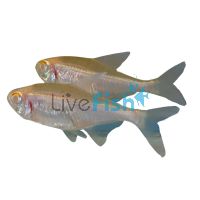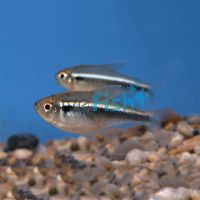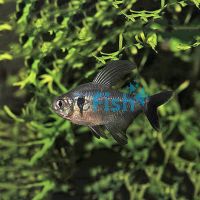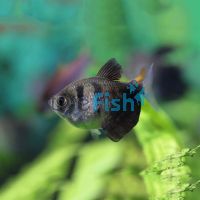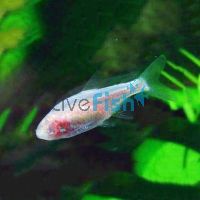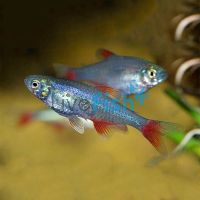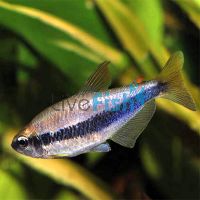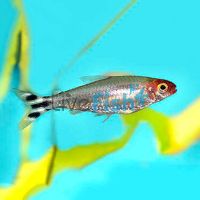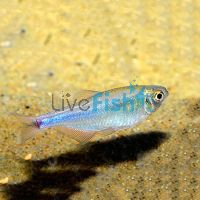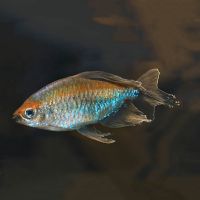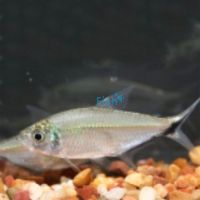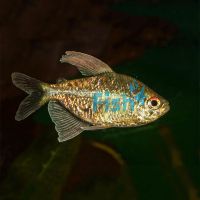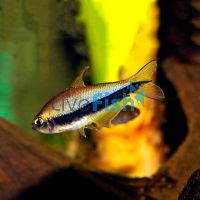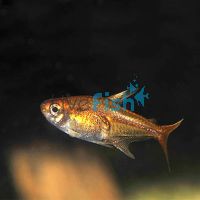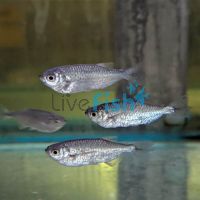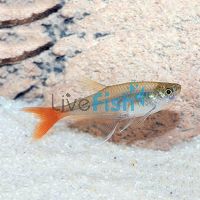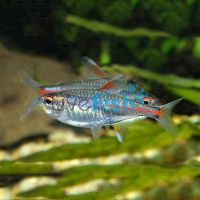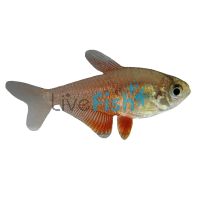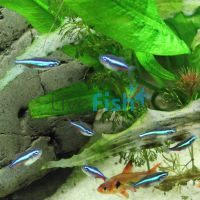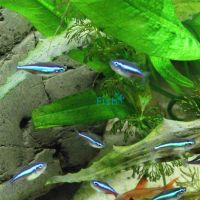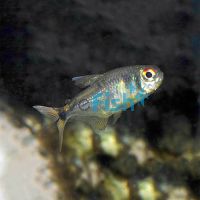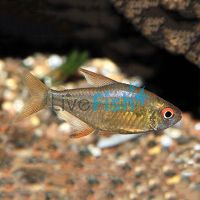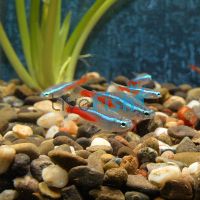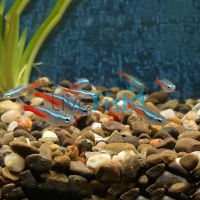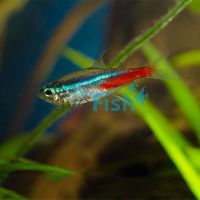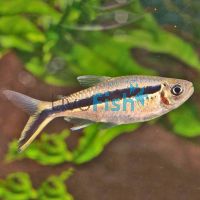Tetras max out at 7.5 cm (3 inches) for the largest common species, with the majority of tetra species reaching only 3.8 cm (1.5 inches) max. They have relatively long lifespans, somewhere around 6 to 8 years being fairly typical for a healthy tetra. Most tetra species feature elongated bodies with iridescent scales and splashes of bright colours, though you will find a lot of diversity in shape and colour amongst this family.
Tetra Care
Almost universally low maintenance, tetras can handle fairly diverse water parameters. They are unfortunately quite prone to disease, so be sure to monitor for ammonia and nitrate spikes regularly, keep up with water change schedules and follow the quarantine rules before introducing new fish to your main aquarium. Other than this, tetras are easy to care for as long as you follow a few simple rules. By far the most popular tetra species (and arguably one of the most popular fish species in the hobby) is the Neon tetra, with other popular species including the Black Neon tetra, Diamond tetra, Rummynose Tetra and the more circular-bodied Golden Black Widow tetra.
Natural Habitat
Most tetra species are native to southern America, commonly found in the Amazon basin. However, being quite a diverse family, they can also be found in Central America and central-west Africa. A relatively new discovery has been that of the Blind tetra, found in Mexican cenotes. As a general rule, tetras enjoy cool active freshwater streams, but they can also be found in ponds, floodplains and tannin-stained lakes.
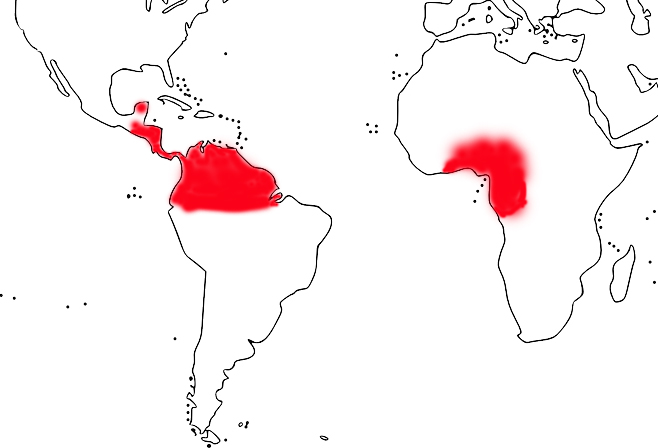
Behavior/Compatibility for Tetras
The vast majority of tetra species are peaceful and confident fish, though there are some exceptions to this. For example, the rare Bucktooth Tetra is an extremely aggressive fish that can dominate even cichlids, despite its less imposing size. Black widow tetras are known for fin-nipping more extravagantly-finned species such as Angelfish and should not be housed with any species that is susceptible to being bullied. As always, be sure to consult the individual species’ needs and behaviour before introducing them to your community tank. That said, most popular tetra species such as the Green Neon, Golden Neon, Cardinal Tetra or classic Neon Tetra, Cardinal Tetras, and Fire-ember tetras are wonderful community tank additions. Tetras are a schooling fish and should absolutely not be kept individually. The recommended shoal size depends on the species, but as a rule, no fewer than 10 tetras should be housed together, with more always being better. For the majority of tetra species, great tank mates include Swordtails, Corydoras catfish, Guppies, Rasboras and Danios.
Housing Tetras and Aquarium Fish Tank Set-up Tips
Tank
Tetras require little room individually, but the necessity of keeping them in large groups will require a relatively larger aquarium. As a general rule, you should be keeping shoals of no fewer than 10 tetras, though this does vary between species. Tetras prefer lower light with slight water movement. Ensure your aquarium has a lid as they are known to jump. For brevity, the following table will be regarding the most popular smaller tetra species such as the Neon Tetra, Cardinal Tetra, and Fire-ember. Please check the individual requirements of your preferred species before purchase.
Recommended Max Fish Count Tank Volume 10 Tetras 39 litres (10 gallons) 15 Tetras 47 litres (12.5 gallons) 20 Tetras 57 litres (15 gallons) 30 Tetras 72 litres (19 gallons) Base
Tetras are mid-level swimmers, meaning the type of substrate will not be a major concern. You may select this based on the needs of your other fish species. You should however opt for a dark substrate in which plants can grow well.
Foliage
Tetras require a well planted freshwater aquarium, with bunching, leafy plants being optimal to help provide shade. Some of the best plants include Java Fern, Pennywort and Ludwigia. Some driftwood is also recommended as the dark shade really brings out the tetra’s colours.
Water
Tetras prefer cooler, soft waters bordering on the acidic. They can handle a fairly wide range of parameters, but you should ensure ammonia and nitrate spikes are controlled before introducing tetras to your tank. Temperatures should be around 20 to 28 degrees C (68 – 82.4 F). Depending on your local climate, you may need to install a water heater to ensure the temperature stays within this range. You will find other aquarium decor and accessories in this section too, for example airstones or an air pumps for aquariums.
Your Ph should be 5.5 – 7.5 and you should aim for a hardness of 5 - 15 DGH. To ensure your pH and hardness are suitable we recommend checking out our aquarium supplies and accessories section where you should invest in a testing kit. Always ensure your water is properly filtered, and regularly change the water (25% weekly or 50% every other week). This is especially important for tetras.
You should also filter the substrate regularly and adjust the chemistry of any tap water you use to top your tank. You may do this with one of our many water conditioning products .
Feeding and Care
Tetras are mainly carnivorous, though some plant-based foods should also be provided. High-quality prepared fish foods like flakes and slow-sinking pellets are a great start, but live food like bloodworms, live or frozen brine shrimp and daphnia should also be provided. Vegetables such as broccoli, peas and cabbage should also be in their diet, though you must ensure they are well blended so the tetras can swallow the pieces whole.
Great reasons to keep Tetras in your tropical fish tank
- • Tetras are typically a very passive fish that will get along very well with similar-sized friendly species
- • Shoaling tetras add a lot of life and colour to any tropical fish aquarium.
- • Tetras are easy to care for and should provide many years of visual pleasure.
Tetras are among the most popular species in the fish-keeping hobby today. You can shop for fish from our online tropical fish store, see the different varieties we currently have in stock below. Will you go for one of our packages of Mixed Neon Tetras, a pack of Classic Neon Tetras or Phantom Tetras or pick out a few species like the Purple Pencilfish or Dark Marble Hatchet fish.
